Time Travel Research Center © 2005 Cetin BAL - GSM:+90 05366063183 - Turkey/Denizli
Nuclear Chemistry
The First Atomic Bombs
Dr.Frank Settle
|
The fissionable materials, solid uranium tetrafluoride from Oak Ridge and plutonium nitrate paste from Hanford, began to arrive at a secret laboratory in Los Alamos, New Mexico, in late 1944. On the lava flows of an extinct volcano 35 miles north of Santa Fe, Robert Oppenheimer, a brilliant physicist from the University of California, led the development of the first nuclear fission weapons. Chemists purified the two metals and metallurgists shaped them into forms suitable for the weapons. Plutonium presented unique problems because it had never been isolated in large amounts and because the solid had six separate phases. |
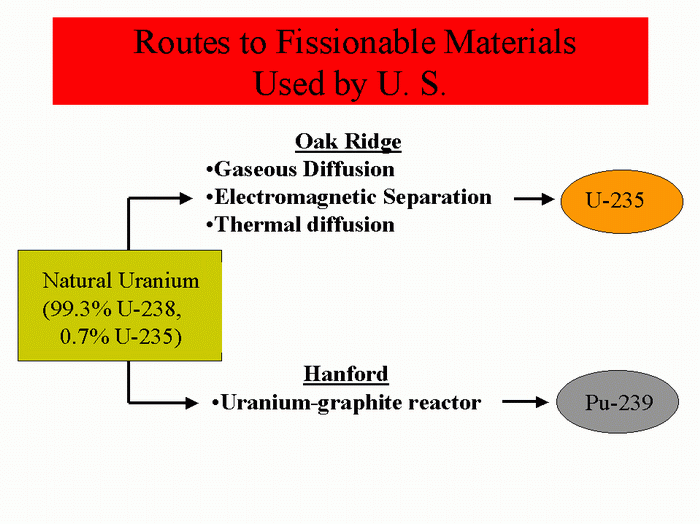 |
At first glance, making a fission bomb is simple: assemble a supercritical mass of fissile material and a chain reaction will rapidly produce neutrons that, in turn, generate more fission and neutrons. The challenge is to bring two subcritical masses together quickly before the energy released by the initial fission blows the masses apart and stops the chain reaction.
The physicists had to answer two fundamental questions: How much fissile material would be required for the weapons and how much time would be needed for an effective detonation? The initial calculations for the U-235 bomb looked like this:
They wanted a 20-kiloton explosion (equivalent to 20,000 tons of TNT), so
20 kilotons TNT = 1 x 1013 cal = 8.4 x 10 13 joules
If each fission produces 3.2 x 10-11 joules, then the number
of fissions (N) required is
N = (8.4 x 1013 joules)/(3.2 x 10-11joules per fission) = 2.6 x 1024 fissions
Thus, the mass of U-235 required would be
moles235 = 2.6 x 1024 atoms(1 mole U-235/6.02 x 1023 atoms) = 4.3 moles U-235
The physicists calculated a 10% efficiency for the weapon so
m235 = 4.3 moles (235 g/mole)/0.10 @ 10 kg U-235
The basic equation for neutron production is exponential.
Nn = N0e(k 1)n
If N0 = 1 and k 1.693, then Nn = N0 e.693n = 2n (1)
One might expect that k, the number of neutrons produced per fission, to be larger. Neutron absorption by U-238 and leakage of neutrons from the supercritical mass, however, reduce the number of neutrons available to sustain the chain reaction.
This exponential equation generates the following data. Remember that the total number of neutrons produced at the time of a particular generation is the sum of all of the neutrons from all generations. Thus, in the 4th generation (n = 3), 15 neutrons have been produced.
|
n (generation) |
N |
Total # neutrons produced |
n (generation) |
N |
Total # neutrons produced |
|
1 |
1 |
1 |
10 |
1024 |
1.28 x 103 |
|
2 |
2 |
3 |
20 |
1.05 x 106 |
1.05 x 106 |
|
3 |
4 |
7 |
30 |
1.07 x 109 |
1.07 x 109 |
|
4 |
8 |
15 |
40 |
1.10 x 1012 |
1.10 x 1012 |
|
5 |
16 |
31 |
50 |
1.13 x 1015 |
1.13 x 1015 |
|
6 |
32 |
63 |
60 |
1.15 x 1018 |
1.15 x 1018 |
|
7 |
64 |
127 |
70 |
1.18 x 1021 |
1.18 x 1021 |
|
8 |
128 |
255 |
80 |
1.24 x 1027 |
1.24 x 1027 |
How long will it take to generate the number of fissions required to produce the energy equivalent to 20 kilotons of TNT? First, we need to calculate the number of generations. Substituting into Equation 1:
(½ ) 2.6 x 1024 = 2n
ln(1.34 x 1024) = (n)ln2
n = 80 generations
How long will it take to release this energy? The time period for one generation is the time required for a neutron to travel across the diameter of the critical mass. We need to calculate the diameter of the critical mass assuming a sphere.
Density = mass/volume Volume = (4/3) P r3
r = 3 m/(4P d) = 0.05 m, where d = density of uranium = 1.87 x 104 kg/m3
Physicists experimentally determined the velocity (v) of neutrons to be 1 x 107 m/sec, so the time (t) required for a single generations is
t = 2r/v = 0.1 m/107 = 10-8 sec for one generation
Thus, the time for 80 generations is approximately 80 x 10-8 sec or 1 microsecond. The exponential growth of neutrons means that the last 10 generations produce approximately 99.9% of the energy in the explosion. Thus, it is important to keep the supercritical mass together long enough to release the desired amount of energy.
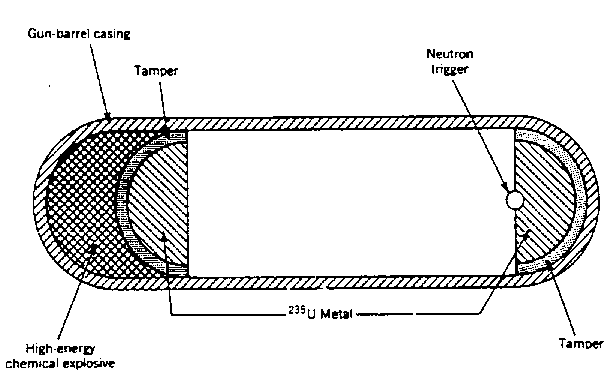
Little Boy: Gun-type uranium bomb
To prevent spontaneous detonation of an atomic bomb, the fissile material is kept in a subcritical configuration. It is then rapidly assembled into a supercritical mass using conventional explosives. Once the bomb has achieved this mass, any neutron introduced into it will be likely to initiate a chain reaction. The mechanism for "Little Boy", the U-235 bomb, was a gun that fired one subcritical piece of U-235 into another to form a supercritical mass. The pieces had to be assembled within a time less than the average time between appearance of a spontaneous neutron from either U-235 or cosmic radiation. A conventional explosive in an artillery barrel could fire the U-235 mass at speeds of a few millimeters per second, fast enough to prevent a fizzle caused by a spontaneous neutron setting off a premature chain reaction.
Originally, the gun-type mechanism was planned for both the U-235 and Pu-239 weapons. However, a problem arose with the Pu-239 bomb that required a different assembly mechanism. A small amount of Pu-240 is produced with the Pu-239 in the reactor.
Pu-240 emits large numbers of neutrons spontaneously: 1,030 neutrons per gram per second compared with 0.0004 neutrons per gram per second for U-235. Even at a concentration of 1% Pu-240 in the fissile Pu-239, the required mass of Pu emits 52,000 neutrons per second or one neutron every 20 microseconds. Thus, it is very probable that a neutron from Pu-240 will initiate a premature chain reaction during the critical last 100 microseconds in a gun-type assembly. This problem was discovered in mid 1944, well after the start of construction of the massive Hanford plutonium production facilities.

Fat Man: Implosion-type bomb
Removal of the Pu-240 was impractical. So the scientists and engineers looked for a faster method of assembling the plutonium. A mechanism based on implosion provided the solution to this problem. In this design, the fissile material is shaped into a single sphere with a mass slightly less than critical. Layers of carefully shaped high explosives surround the sphere. When the explosives are detonated, the force of the shock wave compresses the fissile material into a smaller volume, forming a supercritical mass. This method of assembly is much faster than the gun-type mechanism and thus eliminates the problems resulting from spontaneous neutron emission of Pu-240. The spherical mass resulted in a pumpkin-shaped weapon called "Fat Man".
To assure that a chain reaction occurs, an initiator is placed at the center of the sphere of fissile materials. It consists of a source of alpha particles, radioactive polonium, surrounded with thin aluminum foil. The foil-wrapped source is then surrounded with beryllium powder. When the initial explosion squeezes the fissile material into a supercritical mass, the foil breaks, allowing the alpha particles to reach the beryllium and produce the initial neutrons.
![]()
4
He2 + 9Be4 ® 12C6 + 1n0Initiator for atomic bombs
Placing a neutron-reflecting material around the fissile material reduces the amount of Pu-239 or U-235 required to achieve a critical mass. This material increases the efficiency of the weapon in two ways: It reduces the loss of neutrons by leakage by reflecting them back into the supercritical mass and it serves as material against which the expanding fission reaction can push. This latter function became known as "tamping" and increased the period of time before the weapon blew itself apart. Beryllium was often used as a tamper material.
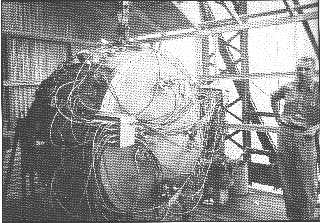
The Gadget at the Trinity Test
Site
(Courtesy of the Department of Energy)
In July 1945, the United States had enough fissile material for one uranium and two plutonium weapons. The scientists and engineers felt confident that the gun-type assembly mechanism for "Little Boy" would function properly. Besides, they did not have the material for a test device. They were less confident about the implosion mechanism and felt that a test was necessary. On July 16, 1945, the first nuclear weapon, known as "The Gadget", was placed on a 100-foot tower and successfully detonated in the Alamogordo Desert, 200 miles south of Los Alamos.
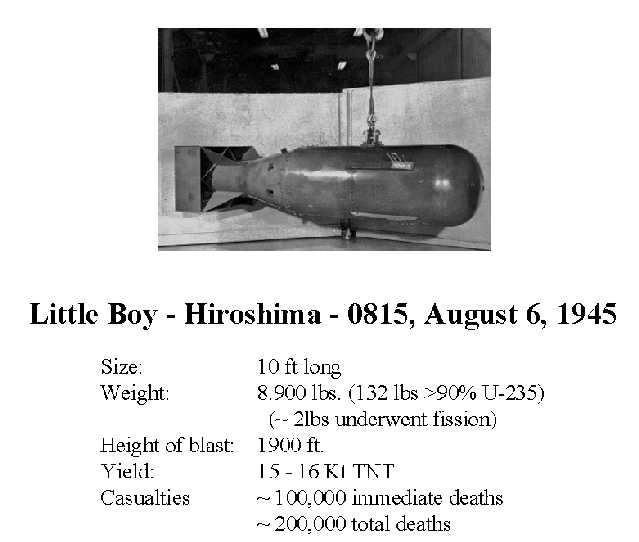
As the war with Japan continued and a costly allied invasion loomed as a real possibility, President Truman approved the use of nuclear weapons against selected Japanese targets. The U.S. Army Air Force received orders to drop these weapons anytime after August 3, 1945. On August 6, "Little Boy" fell on Hiroshima. Three days later, "Fat Man" destroyed Nagasaki.
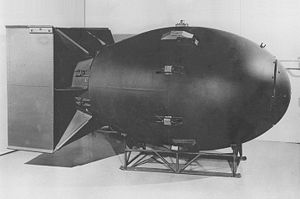
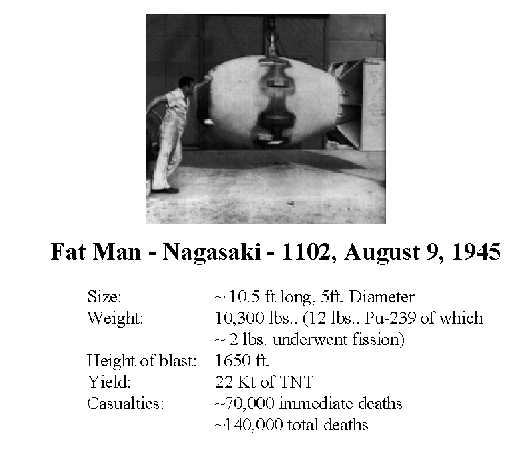
Complete Bibliography on Nuclear Weapons Design from the ALSOS Digital Library for Nuclear Issues
Alıntı: http://chemcases.com/2003version/nuclear/nc-09.htm
Hiçbir yazı/ resim izinsiz olarak kullanılamaz!! Telif hakları uyarınca bu bir suçtur..! Tüm hakları Çetin BAL' a aittir. Kaynak gösterilmek şartıyla siteden alıntı yapılabilir.
The Time Machine Project © 2005 Cetin BAL - GSM:+90 05366063183 -Turkiye/Denizli
Ana Sayfa /İndex /Roket bilimi / ![]() E-Mail /CetinBAL /Quantum Teleportation-2
E-Mail /CetinBAL /Quantum Teleportation-2
Time Travel Technology /Ziyaretçi Defteri / Duyuru / UFO Technology